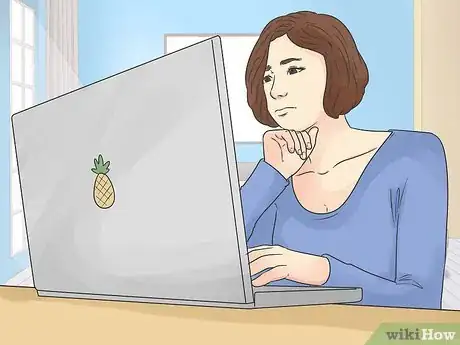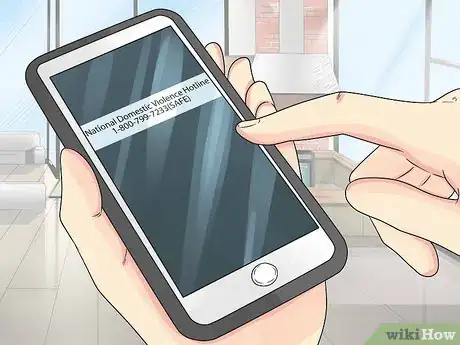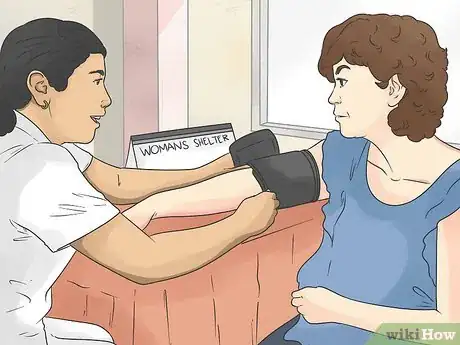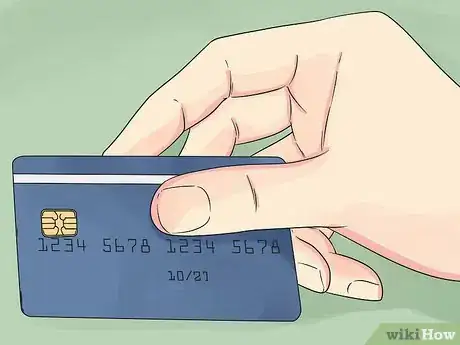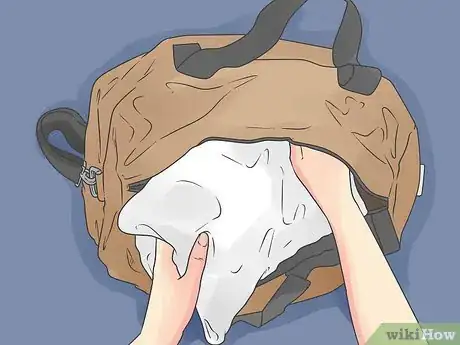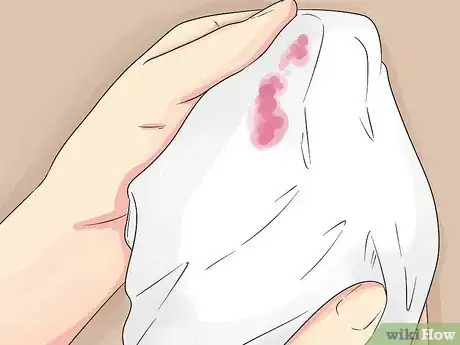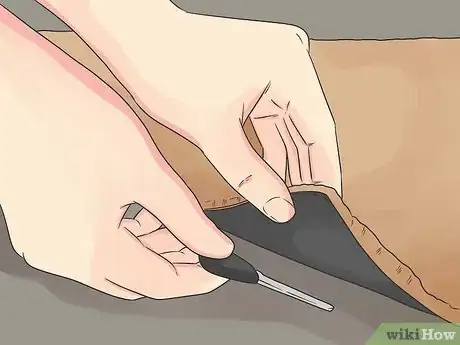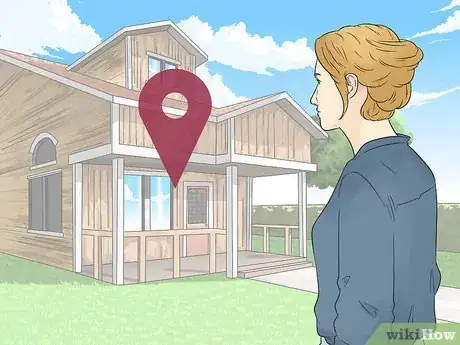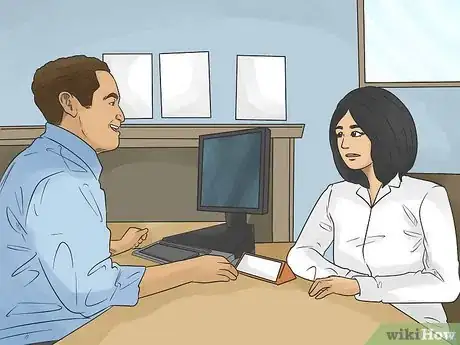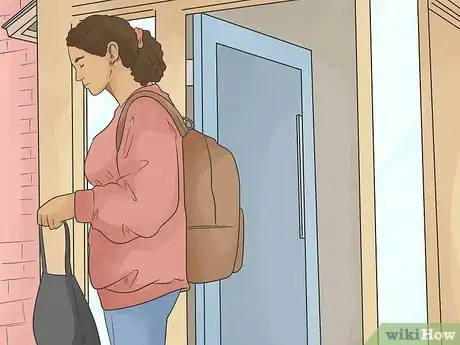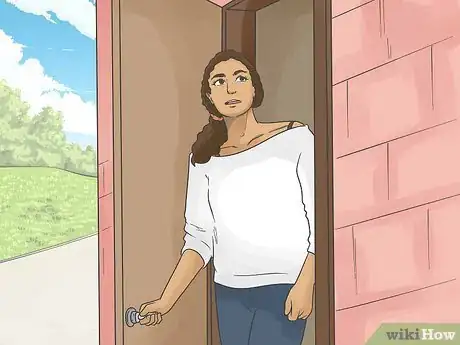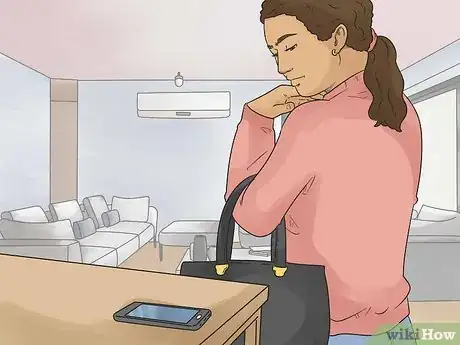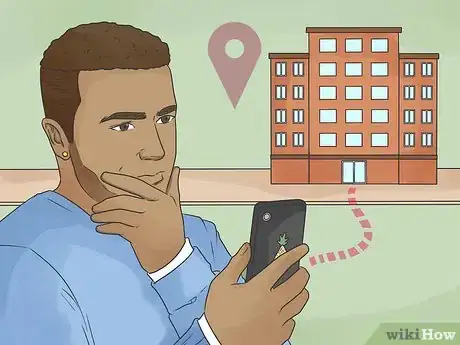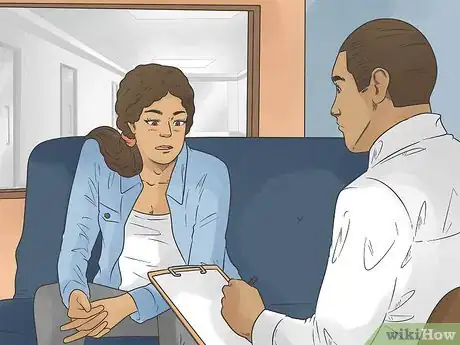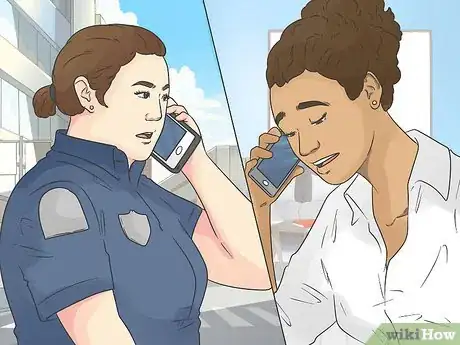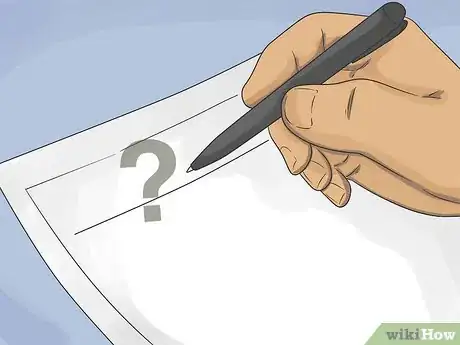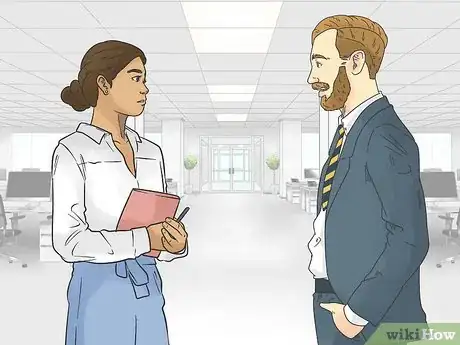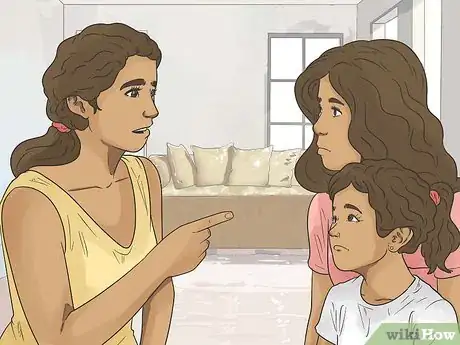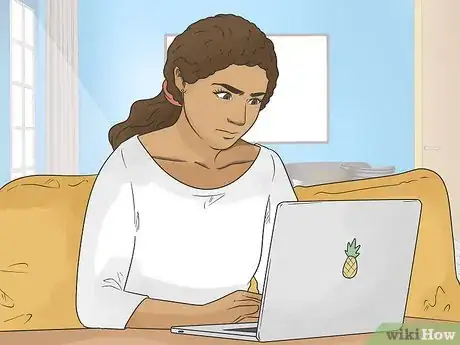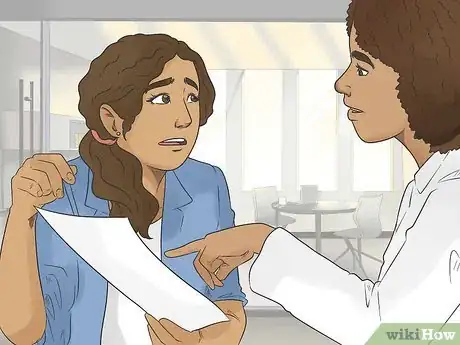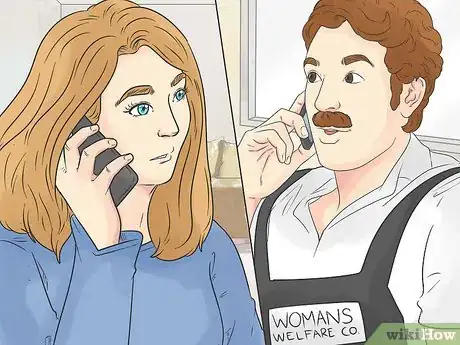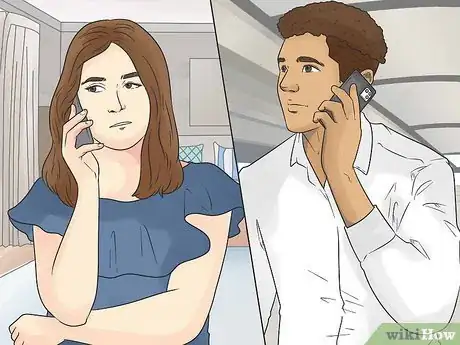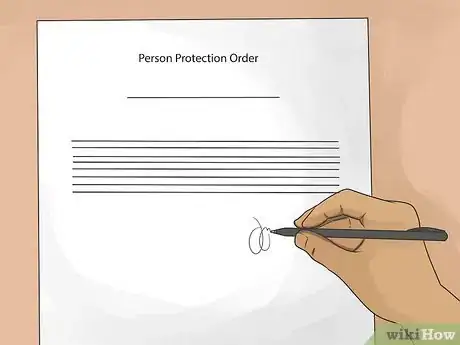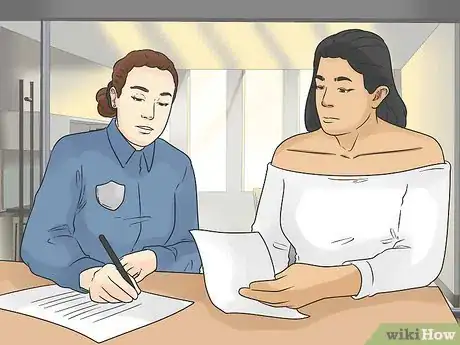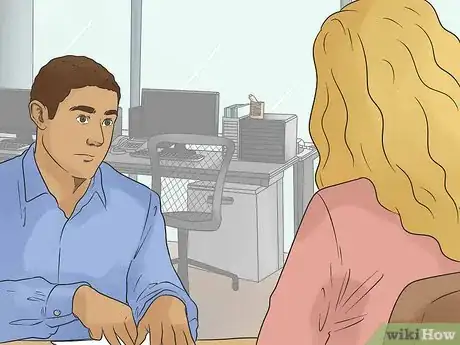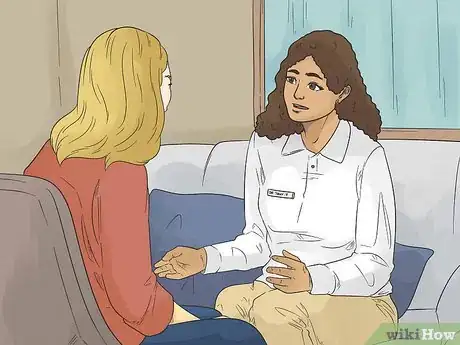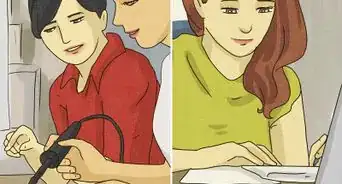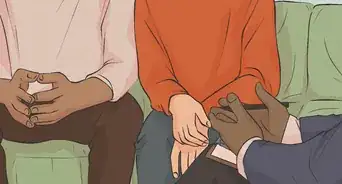This article was co-authored by Moshe Ratson, MFT, PCC. Moshe Ratson is the Executive Director of spiral2grow Marriage & Family Therapy, a coaching and therapy clinic in New York City. Moshe is an International Coach Federation accredited Professional Certified Coach (PCC). He received his MS in Marriage and Family Therapy from Iona College. Moshe is a clinical member of the American Association of Marriage and Family Therapy (AAMFT), and a member of the International Coach Federation (ICF).
This article has been viewed 159,440 times.
Leaving an abusive relationship can be quite difficult. Victims of abuse often do not realize that they are being abused or they are led to believe that they are the cause of their own abuse. Once you realize that you are being abused and you are ready to leave, you should do so quickly and carefully to avoid potential escalation and violence that could endanger your life. Don't be afraid to ask for help, use any and all resources available to you, and get out safely.
Steps
Getting Help
-
1Find a secure means of seeking help.[1] Phone records and call logs can be checked. Computers' browser histories can be traced. You can try erasing your call log or internet cookies and history. Some browsers also allow you to set them to “private” mode. But if you are worried that your abuser is monitoring your communication with others, you might want to find another computer or phone to use.
- Most public libraries offer computers with internet access to community members. This could be a good place to start.
- You may want to get a prepaid cellular phone. This could come in handy while looking for help and later, when you actually leave.
- You could also use a friend or neighbor's computer or phone. If necessary, make an excuse such as your own computer or phone being broken.
-
2Contact an organization that can help. Most areas have local resources to help victims of abuse. If you are not sure where to start or if you want to talk to someone about planning to leave an abusive relationship, begin with the following resources.
- In the US: National Domestic Violence Hotline 1-800-799-7233(SAFE)
- Men in the US can contact The Domestic Abuse Helpline for Men and Women
- In the UK: Women's Aid 0808 2000 247
- Men in the UK can contact ManKind Initiative
- In Australia: 1800Respect 1800 737 732
- Men in Australia can contact One in Three
- Worldwide: The International Directory of Domestic Violence Agencies
Advertisement - In the US: National Domestic Violence Hotline 1-800-799-7233(SAFE)
-
3Find a battered women's shelter. If you are a woman who is a victim of abuse, find a battered women's shelter in your area (or a nearby town). Be aware that the physical location of such shelters is usually kept secret for the protection of the women in the shelter, but you should be able to call a hotline or go through a screening in a physical location. Then you will be referred to the shelter.[2]
- Most shelters allow for a safe place to live for both women and children. They are designed to offer safety and support while you get back on your feet, but your stay there will be for a limited amount of time.[3]
-
4Talk to friends or family.[4] Unfortunately, many victims of abuse withdraw or are forced to become isolated. This often leads victims to believe that they have no one to help them escape their abuser. However, friends and family, even if you have been out of touch, may pull through and help you get out of a bad situation. Reach out to someone you trust and ask for help.
- Try to be specific with what you would like for them to do for you (such as let you stay with them, keep your “escape bag,” call the police for you if you give them a “code word,” etc.)
Making an Escape Plan
-
1Establish emergency funds or credit.[5] If your abuser keeps money tightly controlled, withholds money from you, or does not allow you to earn your own money, it can be difficult to establish an emergency fund. Keep any change you can keep, return items to a store for cash back, hide any money given to you as a gift, or find other ways to build some emergency cash. If you can't get emergency cash, try applying for a credit card in your name, but be sure that you have statements sent to a PO Box, a work address, or even to a friend's house so that your abuser does not find out. Do not access your credit card account from your home computer.
- Having a credit card can help you establish or build credit (as long as you pay it off responsibly), which you may need for independent living after you leave.
-
2Pack and hide a “getaway bag.” You should have an emergency bag with necessities in it.[6] Be sure that you hide the bag very well (you may even want to leave it at someone else's house.) You pack light, but include the following in your bag:
- Changes of clothing for you and any children
- Copies of important documents (birth certificates, passports, driver's license, bank or credit card account information, paystubs, social security card(s), etc)
- Medications for you or your children
- Special personal items like photographs or jewelry
- Non-perishable snacks[7]
-
3Gather evidence of abuse.[8] You should certainly not provoke instances of abuse solely to gather evidence, but it may help you take legal action in the future if you do collect evidence of abuse. Take pictures of injuries, destroyed objects, or a room that was trashed during a violent episode, keep bloodied clothing or towels, and collect any documentation about hospital visits due to abuse.
- Whenever you are injured in an episode of violence, you should seek medical treatment in the emergency room and keep the records. This could be key to being awarded an order of protection, custody or your children, or a contested divorce.
- It is common for victims of abuse to be unsure of their sanity. Hours or days after a violent episode, they start wondering whether they have provoked partner's aggression, whether this is their fault. Documenting all the dialogues with your boyfriend or husband, their and your actions in a diary will help retain a clear picture of everything that happened to you. Also, these records will come in handy if you need to replicate the experience in a police office.
-
4Hide an extra car key.[9] If your access to a vehicle is restricted, try to have an extra key made for your car. If there is already an extra key, hide it in a place that you can easily access it on your way out. Check the spot prior to your departure to ensure that your abuser has not found the key and removed it.
- You should also keep your vehicle ready to leave; park facing out so that you can drive away quickly. Keep your car fueled with gas so that you always have a nearly full tank.[10]
-
5Know where you are going when you leave. While sometimes just getting away is the most important thing, you are more likely to get—and stay—away if you have a plan for where to go. Ideally, you should talk to a shelter, abuse resource center, or a friend or relative ahead of time. In an emergency, however, these places should be able to take you in or refer you to a safe place even without notice.
- If you are going to stay with a friend or relative, try to choose someone who would not be immediately obvious to your abuser.
-
6Make a plan for pets. Too many people (particularly women) stay in an abusive relationship because they fear for what will happen to their pets if they leave. Some shelters may allow you to take a pet with you. If you cannot, you may be able to leave the pet with a neighbor or friend or even take it to a no-kill shelter for safekeeping. In the end, you need to realize that your own life is more important than that of a pet, however difficult that can be to swallow.
-
7Decide whether you should take your children with you. You should talk to an attorney before you leave about taking your children with you. While you should absolutely keep them away from harm, you do not want to harm your potential to keep them safe in the future by harming your chances of getting or maintaining custody of your children.
Getting Away
-
1Leave during a safe window of time. You should most likely leave while your abuser is away from home (unless a violent episode necessitates an immediate escape). Plan and prepare to leave at a time when your abuser will be out of the house, ideally for a few hours. Give yourself plenty of time to gather your emergency bag and get to a safe place before your abuser even realizes that you are gone.
- You do not have to leave a note or an explanation for why you are leaving. It is okay to just leave.
- If you do not have access to your own transportation, make arrangements to have someone pick you up. If you fear that you are in imminent danger, you can have the police pick you up and remove you from your home.
-
2Get away quickly without being followed. While you should likely go straight to your safe place (a shelter or to stay with a friend or family member), you may want to take an indirect route and be observant to be sure that you are not being followed. Try to merge into traffic, take side roads, turn around and retrace part of your route, and notice any cars that seem to be going the same way you are going.
-
3Don't take your cell phone with you. Copy down important numbers in another place (or memorize[11] them.) Your cell phone could be set for tracking without your knowledge, so leaving it behind can help you leave behind your abuser.[12]
- Consider getting a prepaid cell phone and having it packed in your emergency bag. This could allow you to make important calls related to your escape and safety without potentially leading your abuser to you.[13]
-
4Create a false trail after you leave. If you think that your abuser will try to follow you, think about creating a false trail after you have left. Use your own cell phone to place calls to a hotel at least 6 hours away from your true destination. Use a shared credit card or bank account to prepay for the hotel room, and have an email confirmation sent to a shared or monitored email account. You can also book a rental car in the same place or leave a message for a real estate agent and ask her to call you back at your home phone number.
- Do not take these steps before you leave, as they could tip your abuser off as to the fact that you are going to leave, which could incite a violent reaction.
- If you use your own cell phone to create a false trail, be sure to discard it or abandon it before you get to where you are really going.
-
5Go directly to a safe place. Wherever your safe place is, go there. The benefit of going to a shelter or an abuse victim support organization is that they have employees or volunteers who are trained to help you with the “what now?” that you will likely feel after you leave.
- If you do go to stay with a friend or family, you should still consider reaching out to a victim support organization, which can direct you towards legal help, counseling, support groups, employment training, and financial support.[14]
-
6Have a plan to ensure your immediate safety. No matter how careful you are, there may be a chance that your abuser could follow you or track you down. Have a plan for dealing with that contingency. Your plan should probably involve calling the police immediately.
- If your abuser shows up and begs you to come back home, do not go. At this point, the abuser will likely say anything to lure you back home, but you will not be safe if you go back.
Ensuring Anonymity
-
1Use a fake name. When you first check into a shelter or a women's refuge, you do not have to give them your personal information. You can make up a name to go by, particularly on paperwork.[15] This may not be the case when getting legal or financial help, but in the immediate moment, it's okay to be extra cautious.
-
2Do not disclose the location of a shelter. Never disclose where a shelter is located to others. If you tell your abuser, your family members or an abuser's family members, or people who are friends with you and your abuser where a shelter is located, you are endangering your own life and the lives of other women and children in the shelter.
- You may have to sign paperwork saying that you will not disclose the location of a shelter before an organization will take you to the secret location.
-
3Change your work habits. If you have a job, talk to your employer about making changes to ensure your safety. Some states have laws that require employers to make reasonable accommodations for survivors of abuse.[16] Find out if you can change locations, work different hours, or have extra personal security when traveling from your workplace to your vehicle.
-
4Have an unlisted number and confidential address. When you have moved to a new home, get an unlisted home phone number. For mail, get a P.O. Box or ask the post office about your state's confidential address program.[17] These steps will make it more difficult to track down your specific location.
- If you have children, be sure to talk to them about keeping their home address confidential and not sharing it with your abuser or with strangers.
-
5Change all of your passwords. Any account you have online could be a window into personal information. To be safe, change all of your passwords for any account; financial accounts, social media accounts, email accounts, etc.[18] In fact, you may want to disable social media accounts temporarily (or permanently) and change your email address.
-
6Request extra layers of protection. Some companies require only your Social Security Number and your mother's maiden name to access secure information. If you were married to your abuser, he or she likely has this information. Ask if the company offers any additional account protection, or provide an answer to security questions that is inaccurate (but that you still remember). For example, you could provide your paternal grandmother's maiden name instead of your mother's.
Taking Legal Action
-
1Ask a shelter for guidance or resources. Most shelters will provide guidance towards legal help. Some even offer free legal services for survivors of domestic violence.[19] Even if you are not staying at a shelter, you should contact the organization (most have a help line) to inquire about free or low-cost legal services.
- Some organizations help with immigration services for immigrant victims of domestic violence; don't stay in an abusive situation because you fear deportation. You have the right to be free of violence even if you are an immigrant.
-
2Contact an attorney. You will likely need an attorney to support you through the legal battle(s) that you may have to face. If you were married to your abuser, if you had children together, or if you are an immigrant, you will need to make legal changes that an attorney can help with.
- If you do not have money, you may still be able to get an attorney. Some attorneys will include a suit for fees from your abuser in the event of a court case in your favor. Some may also take your case “pro bono,” or as an act of charity.
-
3File for a personal protection order (PPO). A PPO is a court-backed document that allows you legal protection from a past abuser. To file for a PPO, take any and all evidence of abuse you have as well as a letter describing the abusive situation and the relationship between you and your abuser to your local courthouse. They should provide you with further instructions about how to fill out the appropriate paperwork to get a legal PPO.
- After you file for your PPO, if it is approved, it will need to be legally served to your abuser, and you will need to file a proof of service with the court. Talk to the clerk at the courthouse about how to do this.
- Once you have a PPO, keep it with you at all times. If your abuser violates the terms of the PPO, you may need to show the PPO to the police.
- Be aware that a PPO does not guarantee your protection.[20] It makes it easier to have your abuser arrested in the event of further incidents, but a PPO is often not enough to keep a violent abuser away from you completely.
-
4File assault charges. If you have been recently assaulted, or if you have records of abuse (police and/or medical records), file assault charges against your abuser. You might be able to file for assault without physical evidence (particularly if you can provide witnesses to your abuse), but it will be much easier if you collected physical evidence of assault before you left.
- You will likely have a case against your abuser that has multiple levels (for example, you might file for divorce, sue for child custody, file for assault, and request a PPO). The complicated nature of these charges necessitates a lawyer.
-
5Take the appropriate steps for divorce or child custody. Once you have left your abuser, you will need to cut legal ties. If you were unmarried and did not have children, this may be as easy as canceling joint accounts. If you were married and had children, you may face complicated legal battles that will require seeing your abuser (in the courtroom if nowhere else). Be prepared for this by leaning on the support systems you now have in place—the shelter, your legal counsel, your friends and family, and a therapist.
-
6Go to therapy. Whether you prefer the personal attention of a therapist or the community of support from group therapy (or both!), you need to get help. Surviving abuse is not easy, and getting out takes a lot of strength. You need to lean on others to heal effectively, stay strong, and prepare yourself for healthier relationships in the future.[21]
Expert Q&A
-
QuestionHow can I prepare to get out of an abusive situation?
 Moshe Ratson, MFT, PCCMoshe Ratson is the Executive Director of spiral2grow Marriage & Family Therapy, a coaching and therapy clinic in New York City. Moshe is an International Coach Federation accredited Professional Certified Coach (PCC). He received his MS in Marriage and Family Therapy from Iona College. Moshe is a clinical member of the American Association of Marriage and Family Therapy (AAMFT), and a member of the International Coach Federation (ICF).
Moshe Ratson, MFT, PCCMoshe Ratson is the Executive Director of spiral2grow Marriage & Family Therapy, a coaching and therapy clinic in New York City. Moshe is an International Coach Federation accredited Professional Certified Coach (PCC). He received his MS in Marriage and Family Therapy from Iona College. Moshe is a clinical member of the American Association of Marriage and Family Therapy (AAMFT), and a member of the International Coach Federation (ICF).
Marriage & Family Therapist Start saving some money so you can build up an emergency fund if you need to leave.
Start saving some money so you can build up an emergency fund if you need to leave. -
QuestionHow can I inform others about my abuser?
 Moshe Ratson, MFT, PCCMoshe Ratson is the Executive Director of spiral2grow Marriage & Family Therapy, a coaching and therapy clinic in New York City. Moshe is an International Coach Federation accredited Professional Certified Coach (PCC). He received his MS in Marriage and Family Therapy from Iona College. Moshe is a clinical member of the American Association of Marriage and Family Therapy (AAMFT), and a member of the International Coach Federation (ICF).
Moshe Ratson, MFT, PCCMoshe Ratson is the Executive Director of spiral2grow Marriage & Family Therapy, a coaching and therapy clinic in New York City. Moshe is an International Coach Federation accredited Professional Certified Coach (PCC). He received his MS in Marriage and Family Therapy from Iona College. Moshe is a clinical member of the American Association of Marriage and Family Therapy (AAMFT), and a member of the International Coach Federation (ICF).
Marriage & Family Therapist Start tracking their abusive behaviors so you have a log of the things that they've done.
Start tracking their abusive behaviors so you have a log of the things that they've done.
Warnings
- Call 911 or other emergency services if you feel threatened or endangered. You should call the police following any violent attack.⧼thumbs_response⧽
- Do not let a lack of preparation prevent you from leaving when you are in imminent danger. For example, if you have an opportunity and means to leave but you do not have an emergency bag packed, leave anyway.⧼thumbs_response⧽
References
- ↑ Moshe Ratson, MFT, PCC. Marriage & Family Therapist. Expert Interview. 7 August 2019.
- ↑ http://www.helpguide.org/articles/abuse/help-for-abused-and-battered-women.htm
- ↑ http://www.helpguide.org/articles/abuse/help-for-abused-and-battered-women.htm
- ↑ http://www.safehorizon.org/page/create-a-safety-plan-11.html
- ↑ Moshe Ratson, MFT, PCC. Marriage & Family Therapist. Expert Interview. 7 August 2019.
- ↑ http://www.safehorizon.org/page/create-a-safety-plan-11.html
- ↑ http://www.safehorizon.org/page/create-a-safety-plan-11.html
- ↑ Moshe Ratson, MFT, PCC. Marriage & Family Therapist. Expert Interview. 7 August 2019.
- ↑ http://www.helpguide.org/articles/abuse/help-for-abused-and-battered-women.htm
- ↑ http://www.helpguide.org/articles/abuse/help-for-abused-and-battered-women.htm
- ↑ http://www.safehorizon.org/page/create-a-safety-plan-11.html
- ↑ http://www.helpguide.org/articles/abuse/help-for-abused-and-battered-women.htm
- ↑ http://www.helpguide.org/articles/abuse/help-for-abused-and-battered-women.htm
- ↑ http://www.helpguide.org/articles/abuse/help-for-abused-and-battered-women.htm
- ↑ http://www.helpguide.org/articles/abuse/help-for-abused-and-battered-women.htm
- ↑ http://www.safehorizon.org/page/create-a-safety-plan-11.html
- ↑ http://www.helpguide.org/articles/abuse/help-for-abused-and-battered-women.htm
- ↑ http://www.helpguide.org/articles/abuse/help-for-abused-and-battered-women.htm
- ↑ http://www.safehorizon.org/page/domestic-violence-legal-services-24.html
- ↑ http://www.helpguide.org/articles/abuse/help-for-abused-and-battered-women.htm
- ↑ John A. Lundin, PsyD. Clinical Psychologist. Expert Interview. 1 August 2019.
